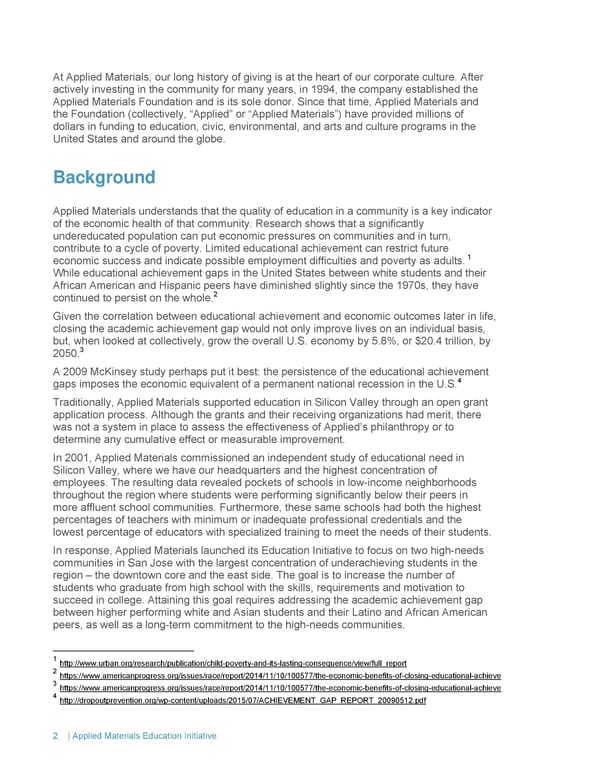At Applied Materials, our long history of giving is at the heart of our corporate culture. After actively investing in the community for many years, in 1994, the company established the Applied Materials Foundation and is its sole donor. Since that time, Applied Materials and the Foundation (collectively, “Applied” or “Applied Materials”) have provided millions of dollars in funding to education, civic, environmental, and arts and culture programs in the United States and around the globe. Background Applied Materials understands that the quality of education in a community is a key indicator of the economic health of that community. Research shows that a significantly undereducated population can put economic pressures on communities and in turn, contribute to a cycle of poverty. Limited educational achievement can restrict future 1 economic success and indicate possible employment difficulties and poverty as adults. While educational achievement gaps in the United States between white students and their African American and Hispanic peers have diminished slightly since the 1970s, they have 2 continued to persist on the whole. Given the correlation between educational achievement and economic outcomes later in life, closing the academic achievement gap would not only improve lives on an individual basis, but, when looked at collectively, grow the overall U.S. economy by 5.8%, or $20.4 trillion, by 3 2050. A 2009 McKinsey study perhaps put it best: the persistence of the educational achievement 4 gaps imposes the economic equivalent of a permanent national recession in the U.S. Traditionally, Applied Materials supported education in Silicon Valley through an open grant application process. Although the grants and their receiving organizations had merit, there was not a system in place to assess the effectiveness of Applied’s philanthropy or to determine any cumulative effect or measurable improvement. In 2001, Applied Materials commissioned an independent study of educational need in Silicon Valley, where we have our headquarters and the highest concentration of employees. The resulting data revealed pockets of schools in low-income neighborhoods throughout the region where students were performing significantly below their peers in more affluent school communities. Furthermore, these same schools had both the highest percentages of teachers with minimum or inadequate professional credentials and the lowest percentage of educators with specialized training to meet the needs of their students. In response, Applied Materials launched its Education Initiative to focus on two high-needs communities in San Jose with the largest concentration of underachieving students in the region – the downtown core and the east side. The goal is to increase the number of students who graduate from high school with the skills, requirements and motivation to succeed in college. Attaining this goal requires addressing the academic achievement gap between higher performing white and Asian students and their Latino and African American peers, as well as a long-term commitment to the high-needs communities. 1 http://www.urban.org/research/publication/child-poverty-and-its-lasting-consequence/view/full_report 2 https://www.americanprogress.org/issues/race/report/2014/11/10/100577/the-economic-benefits-of-closing-educational-achieve 3 https://www.americanprogress.org/issues/race/report/2014/11/10/100577/the-economic-benefits-of-closing-educational-achieve 4 http://dropoutprevention.org/wp-content/uploads/2015/07/ACHIEVEMENT_GAP_REPORT_20090512.pdf 2 | Applied Materials Education Initiative
 Applied Materials Education Initiative Page 1 Page 3
Applied Materials Education Initiative Page 1 Page 3